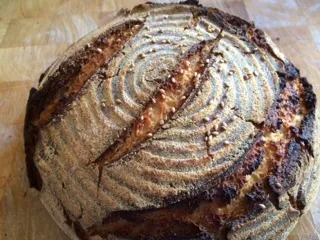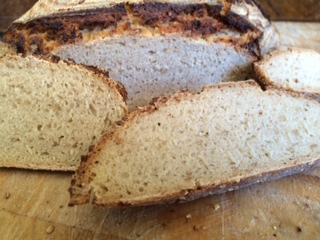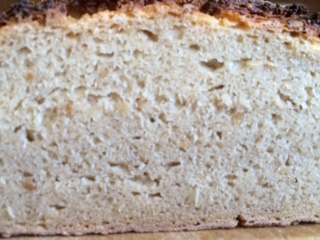
I keep trying to improve my gluten-free bakes. It is so hard to achieve anything close to my gluten loaves, but I did have some improvement on this one. I altered the recipe slightly (see below). The dough is difficult to work with and doesn't hang together too well, so you have to stick with it. It is also a very heavy loaf...very filling.


The crumb is always a bit dense and wet, and I have to eat small pieces, as it is so filling. I maintain my gluten-free starter, but I don't bake loaves very often. Progress is slow, but the loaf was a bit better than the last one. Phyllis
Gluten-Free Sourdough Bread
I used the start of Nicole Hunn’s “No-Rye Rye Bread” for this recipe, but altered it quite a bit. Gluten-free bread is frustrating, but I really wanted to make a sourdough loaf that was edible.
I made a sourdough starter from gluten-free flour and kept it in the refrigerator. I used Nicole’s recipe, but it is confusing and complicated, so when I refreshed it, I just used gluten-free brown rice, oat and tapioca flours. It perked up very well.
Here is the recipe I used:
Starter
80 grams starter
½ cup plus 3 tablespoons bottled water at room temperature
1 cup plus 10 tablespoons gluten-free bread flour (I used Pamela’s gluten-free bread mix)
Dough
Starter
1-1/4 cups plus 2 tablespoons warm bottled water (about 95 degrees)
3-1/4 cup gluten-free bread flour (I used Pamela’s bread mix)
½ cup whole grain gluten-free flour (I used King Arthur’s WW gluten-free)
1 tablespoon salt
1-1/2 tablespoons sesame seeds
Method
Place the starter into the bowl of your stand mixer and add the water; mix using your paddle attachment for a few minutes. Add the bread flour until it is incorporated and switch to the dough hook and knead for about two minutes. Transfer to a lightly oiled bowl, cover with plastic and place it in a warm location until the starter has doubled in size (at least 6-8 hours).
Making the Dough
Once the starter has doubled, add it to your stand mixer bowl along with the water. Mix with the paddle attachment (or by hand) for one minute. Add the bread flour and whole wheat flours and switch to the dough hook. Mix on low speed and knead. Add the salt and mix on medium speed for about three minutes. Add the seeds and mix until incorporated. Place the dough in the refrigerator in a lightly oiled bowl for at least 12 hours or until it is doubled in size. I left it for more than 24 hours.
Shaping the Dough
Take the dough out of refrigerator, ease onto a floured surface and shape into a ball. Place into a banneton coated with brown rice flour (gluten-free). Place in the refrigerator overnight.
Baking
On baking day, preheat your domed covered baker to 500 degrees. Sprinkle some corn meal (gluten-free) into the bottom tray and place the bread on top of the corn meal. Spray lightly with water and score as desired. Bake at 500 degrees with the lid on for 30 minutes and then remove the lid and bake at 450 for another 15-20 minutes.
Cool on a wire rack for at least 30 minute before slicing.
- CAphyl's Blog
- Log in or register to post comments
I'm surprised not to see any Psyllium Husks in the recipe:-) I would be tempted to out some baking powder and soda in there too. rather than have a heavy block of GF bread.. I'm glad you see improvement and light at the end of the tunnel.
dabrownman: Maybe next time I will try some baking powder/soda to get some lift and lighten it a bit. Good suggestion! Thanks. Phyllis
dabrownman: Maybe I will try the husk with a small amount of baking soda/powder next time to help it hang together better and lighten up. Best, Phyllis
p.s. I may be a little slow, but I did get the joke!
That looks so good for a gluten free sourdough! Your perseverance is paying dividends , Phyllis. Great job.
Khalid
I keep trying! Somehow, I don't think I will ever be satisfied with the gluten-free bakes. Best, Phyllis
You achieved such great color and oven spring for a GF loaf! How did it taste? Sour? Bland?Well fermented?
I have dabbled in gf-enough to develop a little familiarity with some of the different flours and dough behavior. My doughs always behaved more like a rye dough than a wheat dough. They seemed to have a better crumb if they were baked lower and slower in order to dry the crumb out. And yet, your dough obviously loved the hot, preheated cloche. Perhaps a hot intro and a slower bake?
The other comment is that you might want to try a different gf flour or mix. The starches (like tapioca,potato starch, and arrowroot) ,as well as the guar gum, can add chew and gumminess if they are too high a ratio with the grain flour. I liked using psyllium but in small quantities. It seemed to bind without being so gummy( like guar&xanthan gum). I have heard people successfully use a combo of psyllium,chia and flax instead of xanthan or guar gum.
I was frustrated with gf baking until I realized I needed to learn how to make something delicious with different ingredients rather than making a wheat clone item with ingredients that don't have the capability of developing those characteristics. There are so many gf ingredients that it is a learning curve to become familiar with all of them (I am LOW on that curve) but just remember-Different ingredients-different deliciousness.
So keep going and bake delicious fun!
clazar123: I like your suggestion of a longer and lower temperature bake. I will try that next time. I do have some psyllium, and could try using that. I agree with you that it has to be used in small quantity. Will continue to share my progress. Thanks so much for your suggestions and comments. Best, Phyllis
Io trovo che il Pane che hai preparato sia straordinariamente bello.
Pensa che sto frequentando un corso di 80 ore proprio sulle intolleranze alimentari ed abbiamo fatto un sacco di lievitati. Straordinariamente buona è stata la pizza....sembrava eseguita con farine tradizionali.
Grazie per questa magnifica condivisione.
Un abbraccio.
Anna
Ringraziamenti così tanto, Anna. Come panettieri, stiamo provando sempre ad imparare e migliorare.
Il glutine libero sta frustrando, come posso mai non ottenerlo appena di destra. Ringraziamenti per il vostri incoraggiamento e supporto.
Un abbraccio. Phyllis
Hi Phyllis,
I applaud you for your efforts with baking gluten-free. A good friend of mine has Celiac and is gluten-free as a result of that. Her biggest complaint about GF "bread" is that it is either cakey or crackery (which makes sense because of the lack of gluten formation). And regardless of the texture, it seems to have a weird sweetness. Can you tell me if your bread is cakey? I would love to make her some sourdough that is actually bready and not sweet.
Thanks,
Mary
Mary: The original recipe for this bread and honey and/or molasses, and I totally cut that out as the sweetness bothered me. I found the dough easier to handle with the honey/molasses, so I will have to work on that in my next try. As I mentioned, sweet breads, or cake breads, work perfectly with GF. It's frankly hard to tell the difference. I make banana bread, cranberry bread and a lemon/orange bread that are quite good. It's the sourdough or savory breads that are tough. I had to make a gluten-free starter, and that worked OK, but it just smells and feels totally different. It's drier and the smell is distinct. I can get it to double, but it doesn't triple or quadruple like my regular sourdough starter, so I think dabrownman's idea of throwing in some baking soda and/or powder may help. I can see that the experiment is on!I wouldn't describe it as crackery, the the dough doesn't hold together as well and does crack quite a bit. I think of cracker as dry, and it's not dry at all, in fact, it is quite wet and heavy. The baked bread is heavy, too. Perhaps the baking soda/powder can help lighten it up a bit. The shaping is a whole different experience than with gluten bread. I'll be sure to post my next GF experiment. Good luck with your efforts and let me know how it goes. Best, Phyllis